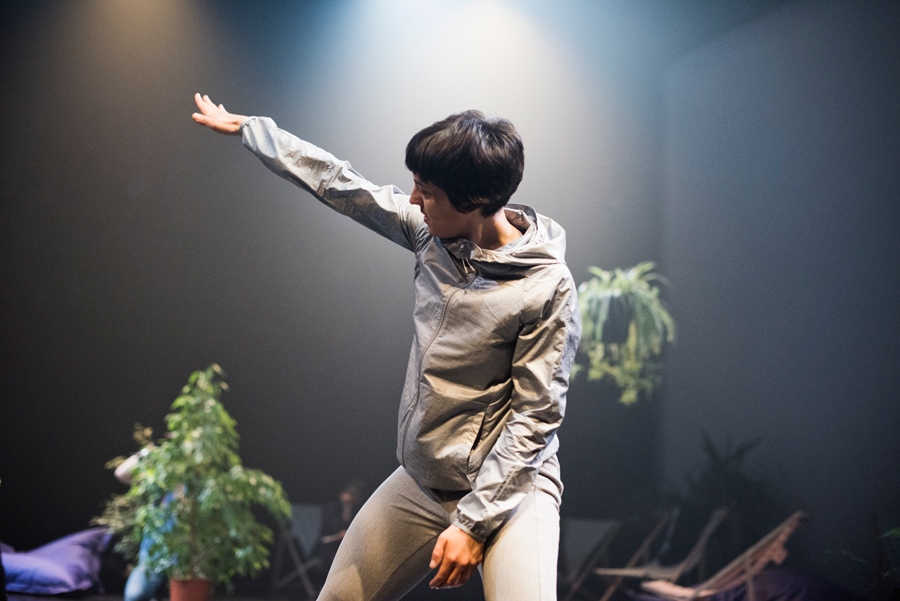The Body is a Technology
Two films and a dance piece focus on our shifting postures in light of connective technology
Two films and a dance piece focus on our shifting postures in light of connective technology

‘The body is a technology’, choreographer Wayne McGregor once said in an interview, adaptive to triggers and objects, to stresses and prostheses, to unforeseeable forces over time. But its scaffold and tissue are also shaped by technology proper: wrists ache beneath smartphones, spines curve over laptops, minds hum from the blue light of screens long after the sun falls. Recent works in film, performance and dance focus on shifting postures in light of connective technology.

Chen Zhou’s Life Imitation (2017) traces, among other impacts of screen-mediated lives, how technology affects the body, disrupting nocturnal patterns, sleep cycles and rest positions. Recently screened in the Experimenta strand of the London Film Festival, in Chen’s film the camera pans across bodies lying horizontal engrossed in elevated screens held over themselves. He films his friends as a naturalist might record nocturnal animals who, when not eating, drinking or partying together, are communicating with one another on WeChat. Arcadian rhythms are aggravated by the constant availability of others. Chen watches silently as friends find sleep in the eventual peace after dawn. And with very effective sound bridging, somnolent bodies shot in Shanghai are cut between insensate bodies in Los Angeles animated through Grand Theft Auto 5’s CGI rendering of the city, ‘Los Santos’. In this dark, post-apocalyptic elsewhere, silent extras lie destitute on roadsides, unconscious at poolsides, or bob up and down in the South Los Santos tide. Chen regards his peers as always plugged in and draining themselves of information. Energy flows change as daily rhythms are altered so that people now carry their bodies differently, too exhausted to sit their heavy flesh upright.

Martine Syms’s recent feature-length film, Incense Sweaters & Ice (2017) – shown at her solo exhibition 'Projects 106: Martine Syms', at the Museum of Modern Art, New York and screened recently at the ICA, London – opens on an image of a woman dancing in a nightclub. Sym’s protagonist, ‘GIRL’ (played by dancer, Katherine Simóne Reynolds), seems unaware of those around her, in a contented state of self-enclosure. The camera lens represents, we begin to discover, the subtle scrutiny of ‘WB’, the white boy this black woman is dating. He never appears as subject himself, but is seen through selfies and video selfies (or ‘velvies’) that appear at intervals on opposite sides of the screen’s vertical margins, as they would on the interface of a smart phone, alternating between speakers. Dialogues are animated onto shots of the woman travelling from Los Angeles, California, to St Louis, Missouri, to Clarksdale, Mississippi, so that our view is as prized apart as it would be in real life, walking a street, for example, while checking messages. In Sym’s observational style, her narrator’s attention is perpetually divided between her embodied self and and her virtual self, participating online. Retracing the path of the 20th century’s 'Great Migration of African Americans’, from rural south to industrial north (along which many of Syms’s family members travelled), the work is, among other possible readings, a study of dislocation, from a homeland, a family, and one’s projected self, and presents moments of relief – like when this woman dances for herself – when that dislocated self seems to be resynchronized, re-located and whole.

In a recent work by Pepa Ubera and Josefina Camus called Ellipsis Land (2017), staged at Sadler’s Wells, London, silent dance offers a meditation on the corporeal experience of the multiply-situated, always communicating subject. In the piece’s first sequence, the two women lie face down on stage, hands and feet scuffling around, without moving anywhere. It’s an odd image, filmed from a camera above, and simultaneously projected live on the theatre wall with the details of a smart phone video on its outer margins. We see the effect of the projected image, where these subjects seem to be making more progress into the darkness than the pair lying face down before us, stuck in this odd, Beckettian scramble.
As the dance evolves, Ubera and Camus appear to have readjusted London’s gravity settings, their bodies flip over, and then flail and struggle against an external force, limbs rising upwards in spite of the weight of their trunks. They eventually take to their feet and struggle to make contact as if battling against some cosmic wind. The sound is very specific, as if recorded in the stratosphere, picking up converging wind currents and an unexpected interplanetary orchestra. Soft distant notes puncture the turbulence, rising and falling in concert with the changing intensities of the dancers’ efforts to connect. They’re wearing the soft jeans and matching wind-sheet jackets of off-duty astronauts, more details suggesting a liminal space of communication technology as a state of suspension between planets and the stars.

In a final sequence, beginning entirely in the dark, the dancers stand centre stage holding two flashlights, which they direct out to trace and explore its limits. The bodies separate and circle the stage, spiraling toward its periphery, climbing walls and mezzanines, until the torches that once peered out have now turned to look back in, surveying centre stage from an outer orbit. With an incredible economy of means, it’s a deft interpretation of how devices for viewing have turned around to inspect us, stalk us and sell us: a dance cosmology of Big Data. Connective platforms intensify already intuitive efforts to congregate among others, but het up in constant conversation, other integral parts of ourselves seem to be getting left behind. As immersed in screen-life as many others, works like these help get the perspective to put my body back in focus. Unplug. Sit up. Stand.
Main image: Martine Syms, Incense Sweaters & Ice (detail), 2017, film still. Courtesy: the artist and Bridget Donahue, New York © Martine Syms




















